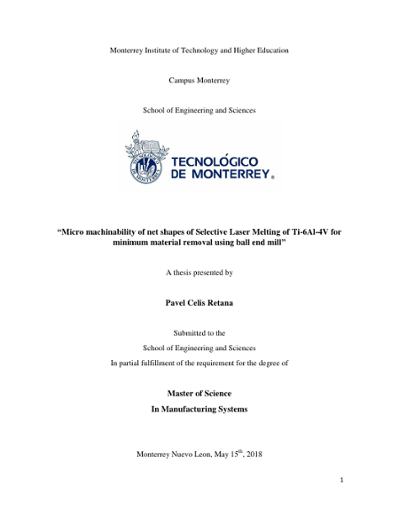| dc.contributor.advisor | Vázquez Lepe, Elisa Virginia | en_US |
| dc.contributor.advisor | García López, Erika | en_US |
| dc.contributor.author | Celis Renata, Pavel | en_US |
| dc.date.accessioned | 2018-06-04T17:07:43Z | |
| dc.date.available | 2018-06-04T17:07:43Z | |
| dc.date.issued | 2018-05-15 | |
| dc.identifier.uri | http://hdl.handle.net/11285/630074 | |
| dc.description.abstract | Miniaturization of medical devices is playing an important role in the manufacture industry. New drug delivery systems are being studied and developed, therefore materials to produce these devices must be investigated extensively. The objective of this work is to experimentally investigate and compare the machinability of Ti-6Al-4V titanium alloy produced via Selective laser melting (SLM) against the conventional machining method. 18 patches of 09 needles each were fabricated and machined with different cutting feeds (120,150 and 180mm/min) with aid of a minimum quantity lubrication (MQL) system. Machinability was examined in terms of cutting forces, tool wear, surface roughness and geometrical dimensions. Each cutting feed was tested by fabricating 3 patches from solid blocks of titanium with square tools of .8mm. Finish pass was performed with a .2mm micro ball end mill with a constant spiral toolpath. Comparison was performed by fabricating four patches with SLM with an excess material of 150μm and machined with the same previous parameters. 3D images obtained by optical microscope reveal that the main force applied in the finishing of needles is the Z axis and cutting forces were higher when machining SLM patches. Tool calibration is the main factor to obtain high precision in geometrical dimensions due to the variation in length because of thermal expansion. Surface roughness for all tests were below 1μm with best results when cutting feed is set at 120mm/min, reduction in edge radius for ball end mills affected negatively the surface roughness. An economic comparison was performed and showed that the SLM combined with SM process has clear advantage over subtractive manufacture alone. | |
| dc.language.iso | eng | en_US |
| dc.publisher | Instituto Tecnológico y de Estudios Superiores de Monterrey | esp |
| dc.rights.uri | http://creativecommons.org/licenses/by-nc/3.0/us/ | * |
| dc.title | Micro machinability of net shapes of Selective Laser Melting of Ti-6Al-4V for minimum material removal using ball end mill | en_US |
| dc.type | Tesis de Maestría | esp |
| thesis.degree.level | Maestro en Ciencias con Especialidad en Sistemas de Manufactura | en_US |
| dc.contributor.committeemember | Rodríguez González, Ciro Ángel | en_US |
| dc.contributor.committeemember | Sandoval Robles, Jesús A. | en_US |
| thesis.degree.discipline | Escuela de Ingenieria y Ciencias | en_US |
| thesis.degree.name | Maestria en Ciencias con Especialidad en Sistemas de Manufactura | en_US |
| dc.subject.keyword | Micro machining | en_US |
| dc.subject.keyword | Titanium | en_US |
| dc.subject.keyword | ball end mill | en_US |
| dc.subject.keyword | Selective laser melting | en_US |
| dc.subject.keyword | manufacturing systems | en_US |
| thesis.degree.program | Campus Monterrey | en_US |
| dc.subject.discipline | Ingeniería y Ciencias Aplicadas / Engineering & Applied Sciences | en_US |
| refterms.dateFOA | 2018-06-04T17:07:44Z | |
| html.description.abstract | <html>
<head>
<title></title>
</head>
<body>
<p>Miniaturization of medical devices is playing an important role in the manufacture industry. New drug delivery systems are being studied and developed, therefore materials to produce these devices must be investigated extensively. The objective of this work is to experimentally investigate and compare the machinability of Ti-6Al-4V titanium alloy produced via Selective laser melting (SLM) against the conventional machining method. 18 patches of 09 needles each were fabricated and machined with different cutting feeds (120,150 and 180mm/min) with aid of a minimum quantity lubrication (MQL) system. Machinability was examined in terms of cutting forces, tool wear, surface roughness and geometrical dimensions. Each cutting feed was tested by fabricating 3 patches from solid blocks of titanium with square tools of .8mm. Finish pass was performed with a .2mm micro ball end mill with a constant spiral toolpath. Comparison was performed by fabricating four patches with SLM with an excess material of 150μm and machined with the same previous parameters. 3D images obtained by optical microscope reveal that the main force applied in the finishing of needles is the Z axis and cutting forces were higher when machining SLM patches. Tool calibration is the main factor to obtain high precision in geometrical dimensions due to the variation in length because of thermal expansion. Surface roughness for all tests were below 1μm with best results when cutting feed is set at 120mm/min, reduction in edge radius for ball end mills affected negatively the surface roughness. An economic comparison was performed and showed that the SLM combined with SM process has clear advantage over subtractive manufacture alone.</p>
</body>
</html> | en_US |



